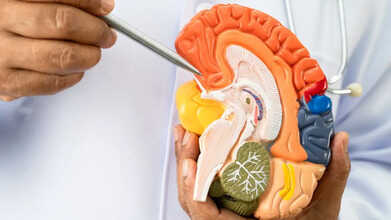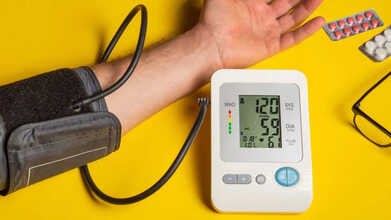- Health Conditions A-Z
- Health & Wellness
- Nutrition
- Fitness
- Health News
- Ayurveda
- Videos
- Medicine A-Z
- Parenting
- Web Stories
What Are Social Anxiety Symptoms?

What Are Social Anxiety Symptoms?
Social anxiety disorder, previously known as social phobia, is a mental health condition characterized by intense anxiety and self-consciousness in everyday social situations. While many people feel nervous or shy occasionally, social anxiety disorder goes beyond normal discomfort. It can significantly impact daily life, relationships, and career prospects, making it essential to recognize the symptoms and explore effective treatments.
Social anxiety disorder is more than just being shy—it’s a complex mental health condition that can disrupt every aspect of life. Understanding its symptoms, types, and treatments is the first step toward recovery. With the right support and intervention, individuals with social anxiety can overcome their fears and lead fulfilling, confident lives.
What is Social Anxiety Disorder?
Social anxiety disorder manifests as a persistent, overwhelming fear of being judged, embarrassed, or humiliated in social settings. People with this condition often experience heightened self-awareness and dread situations where they may feel scrutinized. This fear can interfere with essential aspects of life, such as work, school, or personal relationships.
Unlike shyness, which is a personality trait, social anxiety is a diagnosable condition that disrupts daily life. While shy individuals may occasionally avoid social interactions, those with social anxiety disorder often do so more frequently and experience severe emotional distress as a result. Interestingly, not all people with social anxiety are shy—many feel comfortable in certain situations but become highly anxious during specific events like public speaking, meeting strangers, or eating in public.
Symptoms of Social Anxiety Disorder
The symptoms of social anxiety disorder fall into three main categories: emotional, physical, and behavioral.
Emotional Symptoms
- Intense fear of being judged or negatively evaluated.
- Persistent worry about embarrassing oneself in social settings.
- Anticipatory anxiety that begins days or weeks before an event.
Physical Symptoms
- Blushing, sweating, or trembling.
- Rapid heart rate or feelings of a “mind going blank.”
- Nausea or an upset stomach.
Behavioral Symptoms
- Avoiding social situations or enduring them with extreme distress.
- Rigid body posture, poor eye contact, or speaking quietly.
- Fear of specific scenarios such as public speaking or eating in front of others.
According to the DSM-5, a diagnosis is made when these symptoms persist for six months or more and significantly interfere with daily life.
How Social Anxiety Differs From Shyness
While shyness and social anxiety may appear similar, they are fundamentally different. Shyness is a natural personality trait that does not necessarily hinder daily functioning. Conversely, social anxiety disorder disrupts professional, academic, and personal life, often leading to low self-esteem and depression.
For example, shy individuals might feel awkward in social settings but can still attend events or complete tasks. In contrast, someone with social anxiety disorder might avoid these situations entirely, potentially missing out on important opportunities.
Types of Social Anxiety
Social anxiety disorder can vary in intensity and scope. Symptoms may present as mild, moderate, or severe and impact daily functioning to different degrees.
- Approximately 31.3% of those with social anxiety experience mild disruption in their lives.
- Around 38.8% fall into this category, where symptoms noticeably affect routine activities.
- Severe cases, which account for 29.9%, may lead to significant isolation and inability to function in key areas of life.
The disorder can also be specific or generalized. Some individuals experience anxiety in particular situations, such as public speaking or eating in front of others, while others feel anxious in most social interactions. Common fears include:
- Speaking or performing in public.
- Meeting strangers.
- Using public restrooms.
- Eating or drinking in front of others.
- Being watched while working.
One of the most challenging aspects of social anxiety disorder is the feedback loop created by physical symptoms. For instance, a person may dread blushing or sweating in public, and this fear makes them more likely to experience those symptoms. This vicious cycle heightens anxiety, making social interactions even more stressful.
Treatment for Social Anxiety
The good news is that social anxiety disorder is treatable. With professional intervention, individuals can lead fulfilling lives. The two most common treatments are:
Psychotherapy
Cognitive-behavioral therapy (CBT) is particularly effective in helping individuals recognize and change thought patterns that trigger anxiety. Exposure therapy, a component of CBT, gradually introduces individuals to feared social situations in a controlled environment, helping them build confidence over time.
Medications
Antidepressants and anti-anxiety medications are often prescribed to manage symptoms. Selective serotonin reuptake inhibitors (SSRIs), such as sertraline and paroxetine, are commonly used to treat social anxiety disorder.
Additionally, support groups and self-help strategies, like practicing mindfulness and relaxation techniques, can complement professional treatment.
When to Seek Help
It’s important to seek help if social anxiety significantly interferes with daily life, relationships, or career. Early intervention can prevent the condition from worsening and help individuals regain control over their lives.
If you or someone you know struggles with social anxiety, reaching out to a mental health professional is a vital first step toward healing.
Alzheimer’s In Women: Why Women Are At Higher Risk And How To Detect It Early

Image credits: Canva
Did you know that among the 6.2 million Americans aged 65 and older living with Alzheimer’s disease, nearly two-thirds are women? This means women are almost twice as likely as men to develop the condition. While longer life expectancy partly explains the difference, research shows that hormonal changes after menopause, genetic factors, and certain lifestyle patterns also increase risk.
As a result, understanding the early warning signs and taking preventive steps is especially important for women, who face a higher likelihood of developing Alzheimer’s as they age.
Women and Alzheimer’s: Why The Risk Is Higher
Dr. Brij Lal Choudhary, Consultant Neurologist at Manipal Hospital, Jaipur, points out that Alzheimer’s is often seen as a condition of old age, but women are disproportionately affected. Nearly two-thirds of Alzheimer’s patients are women, making it almost twice as common in women compared to men. While longer life expectancy plays a role, other factors, such as hormonal changes after menopause, genetic predisposition, and lifestyle patterns also increase risk.
Early Signs of Alzheimer’s Women Should Watch
Recognising early symptoms is key, as catching them in time can make a significant difference. Common signs include:Memory loss: Forgetting recent events, appointments, or familiar names, with lapses gradually worsening.
ALSO READ: Chronic Insomnia Could Increase The Risk Of Dementia By 40%: Study
- Difficulty managing tasks or problem-solving: Struggling with daily responsibilities, finances, or planning may indicate cognitive changes.
- Confusion: Feeling disoriented over simple or familiar activities.
- Mood or personality changes: Sudden anxiety, frequent irritability, or withdrawing from social life.
- Language difficulties: Trouble finding the right words or expressing thoughts clearly.
Increased Risk of Alzheimer's in WomenStudies consistently show that women are at a higher risk of developing Alzheimer's disease compared to men. For instance, a Swedish study involving 16,926 participants found that, starting around age 80, women were more likely to be diagnosed with Alzheimer's than men of the same age. Similarly, research in Taiwan indicated that over a seven-year period, women had a higher likelihood of developing Alzheimer's compared to men. A European meta-analysis revealed that approximately 13 women out of 1,000 developed Alzheimer's each year, compared to only seven men, as per Harvard Health Publishing.
ALSO READ: CDC Vaccine Panel Updates COVID-19 Guidelines: What You Need To Know
While the longer life expectancy of women contributes to this disparity, it doesn't fully explain the difference. Even among individuals of the same age, women are more likely to be diagnosed with Alzheimer's than men. This suggests that factors beyond longevity, such as hormonal changes, genetic predispositions, and immune system differences, may play significant roles in the increased risk for women.
How to Reduce Risk and Protect Cognitive HealthAlthough Alzheimer’s cannot be reversed, several steps can help lower risk and support brain health:
- Regular cognitive screenings to monitor changes over time.
- Mental stimulation through reading, puzzles, or learning new skills.
- Physical exercise to improve blood flow and overall health.
- Managing blood pressure and blood sugar to reduce vascular-related risks.
World Alzheimer’s Day 2025: 5 Early Warning Signs of Alzheimer’s Experts Say You Must Know

Credits: Canva
We all experience occasional forgetfulness or feel a bit scatterbrained from time to time, often attributing it to stress, a busy lifestyle, or simply getting older. However, repeated lapses in memory, confusion, or difficulty performing everyday tasks can sometimes signal the early stages of Alzheimer’s or other forms of dementia. Recognising these warning signs early is crucial, as timely awareness and intervention can help manage the condition more effectively and improve quality of life.
As we observe World Alzheimer’s Day 2025, it’s the perfect moment to learn about Alzheimer’s, understand its early indicators, and know what experts recommend paying attention to.
What Is Alzheimer’s?
Alzheimer’s disease is the most common form of dementia, a progressive brain disorder that gradually declines memory, thinking, and reasoning skills. It affects cognitive functioning and daily behaviours to such an extent that simple tasks, like eating, dressing, or walking can become challenging over time.ALSO READ: Chronic Insomnia Could Increase The Risk Of Dementia By 40%: Study
For most people, symptoms first appear in their mid-60s, according to the National Institute on Aging. Current estimates indicate that over 6 million Americans aged 65 and older may be living with Alzheimer’s. Age remains the greatest known risk factor, and with the population aging, the number of cases is expected to rise.
Stages of Alzheimer’sAlzheimer’s disease progresses gradually, with symptoms worsening over time. It is generally divided into three stages: early (mild), middle (moderate), and late (severe). In the early stage, memory lapses and confusion begin to interfere with daily life. During the middle stage, challenges with language, reasoning, and daily activities become more pronounced. In the late stage, individuals may lose the ability to communicate, require full-time care, and become highly dependent on others. Understanding the stages helps families and caregivers plan support and interventions more effectively.
Alzheimer’s vs Dementia
While Alzheimer’s is the most common cause of dementia, the two terms are not interchangeable. Dementia is a broad term describing a decline in cognitive function severe enough to interfere with daily life. Alzheimer’s specifically refers to a progressive brain disease marked by amyloid plaques and tau tangles, leading to memory loss and impaired thinking. Other types of dementia include vascular dementia, Lewy body dementia, and frontotemporal dementia, each with distinct causes and symptoms. Knowing the difference is essential for accurate diagnosis and treatment planning.Early Warning Signs of Alzheimer’s
Recognising the early warning signs of Alzheimer’s can help with timely diagnosis and care. Dr. Prajwal Rao, DM Neurology, Professor and Head of the Department of Neurology at Dr. D. Y Patil Medical College, Hospital and Research Center, Pimpri, Pune, explains:- Persistent Memory Loss: Forgetting recent conversations, events, or important dates more often than usual, affecting daily life.
- Difficulty in Planning or Problem-Solving: Challenges with tasks like handling finances, following recipes, or keeping track of everyday responsibilities.
- Impairment of Spatial Memory: Forgetting familiar routes or even one’s way back home.
- Changes in Mood or Personality: Increased irritability, withdrawal from social activities, or unexpected anxiety and depression.
Blood Pressure Monitoring: How Often Should Patients With Controlled Hypertension Check Their Readings

Credits: Canva
Blood pressure monitoring plays a key role in managing hypertension. For patients whose numbers are well controlled through lifestyle changes or medication, the question often arises: how often should they be checking at home? While regular monitoring helps track progress and detect changes early, checking too frequently can increase stress or lead to unnecessary worry. On the other hand, checking too infrequently may delay important adjustments in treatment. Below, we take a look at how much frequency is important to check your blood pressure.
Home Blood Pressure Monitoring: How Often To Track Your Readings
When you have controlled hypertension, checking your readings at home with a validated monitor is important but doing it properly matters just as much. The CDC and American Heart Association recommend measuring at the same times each day, usually once in the morning and once in the evening. Take at least two readings, spaced 1-2 minutes apart, then average them.
Avoid caffeine, smoking, or exercise in the 30 minutes before taking a reading. Sit quietly for five minutes beforehand, keep your back supported, feet flat on the floor, arm at heart level, cuff on bare skin, and don’t talk during the measurement.
ALSO READ: American Heart Association Updates Hypertension Guidelines: Here’s What To Know
How many times per week? For people with stable, well-controlled blood pressure, checking 3 to 4 times per week may be sufficient. If just starting home monitoring or adjusting treatment, doctors may ask for readings over a week (3-7 days) to get a clear picture.
What is Ambulatory Blood Pressure Monitoring?
Ambulatory blood pressure monitoring (ABPM) is a method doctors use to track and understand high blood pressure over an entire day. Hypertension is diagnosed when the upper reading (systolic) is 130 mmHg or higher, or the lower reading (diastolic) is 80 mmHg or higher.
Unlike the usual check-up at a clinic, where a doctor measures your blood pressure once or twice with a cuff, ABPM gives a more complete picture. For this test, you wear a cuff on your arm that’s connected to a small device strapped to your waist or shoulder. The device automatically takes your blood pressure at regular intervals, every 15 to 30 minutes during the day and about once an hour at night, while you carry on with your normal activities, including sleep.
By the end of 24 hours, your doctor has dozens of readings instead of just one or two. This allows them to see your average blood pressure, how it changes throughout the day and night, and whether there are any unusual patterns. The device also records your heart rate, which adds more detail to the overall assessment.
Why Monitoring Matters Even When Blood Pressure Is Controlled?
Even if your blood pressure is well-controlled with medication or lifestyle changes, regular monitoring remains essential. Blood pressure can fluctuate due to stress, illness, sleep patterns, diet, or physical activity. Some patients may experience ‘masked hypertension,’ where readings appear normal in a clinic but are elevated at home, or ‘white coat hypertension,’ where anxiety in a medical setting temporarily raises readings.ALSO READ: H3N2 Flu Wave Hits Delhi: Paracetamol and Dolo Failing, Expert Reveals What to Take Instead
Tracking your blood pressure helps detect these patterns early, allowing timely adjustments in treatment and preventing long-term complications such as heart attack, stroke, or kidney damage. According to the American Heart Association, even small, consistent changes in readings over time can provide critical insights for maintaining cardiovascular health.
© 2024 Bennett, Coleman & Company Limited

